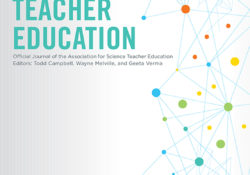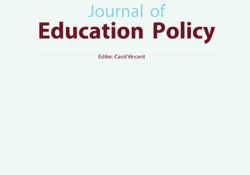eric.ed.gov har udgivet: Employers report a shortage of talent for STEM-specific jobs — and in areas such as health care that require “basic STEM competencies.” The reasons are many, including: lack of authentic learning activities in STEM subjects, little time for science in elementary school, inadequate K-12 teacher preparation in math and science content, poor alignment of K-12 and college curricula, and insufficient collaboration between K-12 and higher education institutions to smooth student transitions from high school to college. But underlying the structural and instructional challenges is an even more fundamental problem — the longstanding debate over what students should know and be able to do by the time they finish high school. This disagreement has resulted in different STEM curricula, different STEM standards — indeed, different expectations of children… Continue Reading →
Like this:
Like Loading...
eric.ed.gov har udgivet: The Learning by Making (LbyM) project is funded by the U.S. Department of Education’s Investing in Innovation Fund (i3). As a five-year development project (2014-2018), Sonoma State University (SSU), in partnership with high-need schools and districts, has been developing an innovative, integrated high school Science, Technology, Engineering, and Mathematics (STEM) curriculum. The curriculum consists of Disciplinary Core Ideas (DCIs) in earth science and biology as described in the Next Generation Science Standards (NGSS, 2013) and utilizes an easy-to-use Logo programming language that conducts data transfer and network communications in support of student-designed investigations. The purpose of this study is to understand how LbyM is implemented in high school classrooms in rural environments, to observe the influences of this curriculum on student learning and engagement, and to explore… Continue Reading →
Like this:
Like Loading...
tandfonline.com har udgivet en rapport under søgningen “Teacher Education Mathematics”: ABSTRACT ABSTRACT The STEM teacher shortage in secondary education makes it important to investigate who is interested in becoming a STEM teacher, so that recruitment initiatives can be adjusted to these students’ characteristics. A latent profile analysis on data from 905 STEM university students identified two types of students with teaching aspirations. The first type (14%) consisted of undecided students who were interested in many careers, had high social interest, and wanted to work in a nice environment with much social contact. The second group (12%) was interested in research, science communication, and teaching. This group had high intellectual and social interest, and wanted to be intellectually challenged. Both groups had high teacher self-efficacy. Implications for teacher education recruitment are… Continue Reading →
Like this:
Like Loading...
eric.ed.gov har udgivet: Teachers do make a difference in student outcomes–and it can be a big one. Research has shown this to be especially true in mathematics, which forms the foundation for all future STEM learning. But most U.S. students do not get a series of good teachers–and highly skilled math and science teachers are not the norm. Excellent instruction requires both deep content knowledge and expertise in teaching that content to all kinds of learners. Developing inspiring STEM instruction is particularly demanding, while STEM teachers are particularly poorly prepared. This STEM Smart Brief describes the research and promising practices regarding teacher preparation, professional development, and school leadership strategies that are effective in improving teacher quality or student outcomes. Link til kilde
Like this:
Like Loading...
eric.ed.gov har udgivet: America’s leaders are increasingly concerned about U.S. competitiveness in a rapidly globalizing world. In response, during the 2006 State of the Union Address, President Bush introduced the American Competitiveness Initiative (ACI) to promote policy that bolsters student achievement in the areas of science, technology, engineering, and mathematics (STEM). At the Business-Higher Education Forum (BHEF) summer 2006 meeting, Secretary of Education Margaret Spellings discussed provisions of the ACI that address teacher shortages in mathematics and science, and corresponding student academic readiness. Specific ACI education provisions include the Adjunct Teacher Corps, the Advanced Placement-International Baccalaureate (AP/IB) Incentive Program, the National Math Panel, Math Now for Elementary Students, and Math Now for Middle School Students. (Contains 2 boxes, 2 figures and 1 table.) Link til kilde
Like this:
Like Loading...
eric.ed.gov har udgivet: While it is important for college and university senior administrators to embrace the traditional roles of their administrative positions, senior administrators’ interactions with students also shape institutional culture, students’ engagement, and ultimately play a role in students’ motivation to succeed. This engagement is especially evident in the Historically Black College and University (HBCU) context as senior administrators’ engagement with students can directly or indirectly affect how students perceive themselves and their ability to succeed. This article aims to illuminate the role that HBCU senior level administrators play in students’ motivation toward success. We also highlight the notion that senior level administrators’ role in organizational culture ultimately led historically-disempowered Black women students toward success in even the most historically inaccessible pathways in the science, technology, engineering, and math… Continue Reading →
Like this:
Like Loading...
eric.ed.gov har udgivet: The purpose of this study was to assess the impact of the Pathways to STEM Initiative (PSI) on students and science teachers and to describe the level of PSI implementation. One group of middle schools participated in PSI, which included project-based science, technology, engineering, and math (STEM) coursework; extra-curricular STEM opportunities for students; and teacher professional development. A multivariate matching algorithm was used to identify a comparison group of schools that received the participating district’s standard science curriculum. The students in the study schools were 62% Hispanic/Latino, 17% Black/African American, and 12% White. Additionally, 23% of the students were English language learners. The study compared students’ science achievement and teachers’ beliefs about science and attitudes toward STEM across the treatment and comparison schools and assessed the fidelity… Continue Reading →
Like this:
Like Loading...
tandfonline.com har udgivet en rapport under søgningen “Teacher Education Mathematics”: ABSTRACT ABSTRACT The extensive reforms of Sweden’s education system during the last few decades have resulted in deregulation and individualization of schools. In upper secondary education, a distinct flexible course structure with multiple options was introduced in order to enhance school effectiveness and equity. This study departs in some of the previously outlined tensions in educational research between market interests and a ‘free choice discourse’ in relation to processes of differentiation. The purpose of this article is to investigate the ways gender patterns may be reproduced in relation to the emergence of multiple options and the re-organization of subject matters within Swedish upper secondary science, technology, engineering and mathematics (STEM) education. Our case addresses relations between discourses of choice and… Continue Reading →
Like this:
Like Loading...
eric.ed.gov har udgivet: This report on the SCALE Institutions of Higher Education (IHE) Case Studies line of work provides preliminary findings about SCALE activities at the University of Wisconsin-Madison (UW-Madison). This study focuses on the structural and behavioral dynamics influencing the implementation of the four core SCALE strategies for effecting change in IHEs: (1) reform undergraduate science, technology, engineering and mathematics (STEM) courses; (2) promote collaboration between STEM and education departments regarding pre-service teacher education; (3) promote collaboration between IHEs and K-12 districts regarding in-service professional development; and (4) improve institutional policies and practices at the IHE level that support faculty engaged in pre- and in-service activities. Preliminary findings indicate that SCALE is making progress in each of these areas. Through the Math Masters and Immersion Unit professional development programs… Continue Reading →
Like this:
Like Loading...
eric.ed.gov har udgivet: The number of jobs in science, technology, engineering, and math (STEM) is growing rapidly and is expected to increase by approximately 1 million in the United States between 2012 and 2022 (Vilorio, 2014). People of many racial/ethnic minorities, however, including Hispanic people, are underrepresented among recipients of STEM degrees and among employees in STEM fields (Beede et al., 2011). Regional Educational Laboratory Southwest conducted this review of the research literature to identify malleable factors that can be measured in K-12 settings and that predict students’ postsecondary STEM success (defined as enrolling in, persisting in, and completing a postsecondary STEM major or degree), particularly for Hispanic students. Identifying these predictive malleable factors can help policymakers and district and school administrators develop and implement interventions that increase the percentage… Continue Reading →
Like this:
Like Loading...

